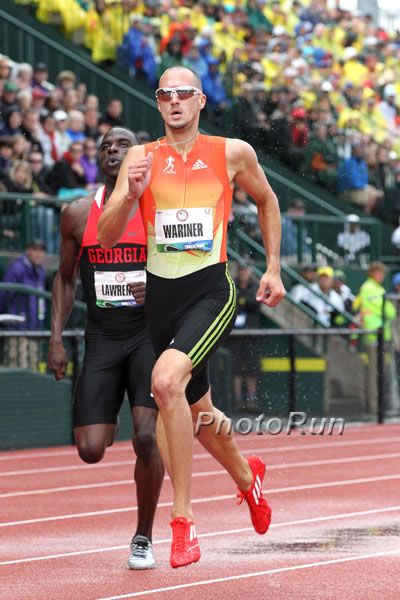Roy Stevenson was fascinated with the challenges that Jeremy Wariner has had, and despite his naysayers, believes that the 2004 World Champion’s best days could and should be ahead of him. Here is Roy’s story:
Jeremy Wariner and the Will to Win
By Roy Stevenson
How does an Olympic Champion (and silver medalist), double Olympic gold medalist in the 4 x 400m relay, double world champ (and silver medalist), and triple world champs gold medalist in the 4 x 400m relay, with a PR of 43.45, continue to run competitively after reaching these pinnacles of atleticism?
I’d been watching Jeremy Wariner compete for several years, up close and personal, in the Golden League then Diamond League meets in Europe. Those were Jeremy’s “unbeatable” days when he blitzed everyone down the home straight. Only great 400 runners actually move away down the home straight, and Wariner did this every time, his rangy legs moving to a strong tempo like a precision Swiss watch.
Today, Jeremy Wariner looks fine for the first 300m but seems to lack his customary sting down the home straight, and a few lucky also-rans are slipping past him. His performances are not as flawless as in the past. It’s almost as if he’s just going through the motions. He left coach Clyde Hart, but has returned and been working with him for 1.5 years. The pundits are starting to make the “he’s past it” noise.
But Jeremy Wariner still has his best years ahead of him. Michael Johnson set his amazing world record when he was 32. Jeremy is only 28, and still has tremendous potential for improvement.
I say this because there are some mitigating factors in Jeremy Wariner’s life. Once Jeremy set his records and standards between 2004-2010, his followers expected him to surpass them at every competition. Thus perfection has only become acceptable to his fans, and any performance below his normal standard is regarded with disdain. I watched the talented Ashton Eaton set his world Decathlon record yesterday, and now everyone expects him to win the Olympic gold and set a new WR. And–mark my words–Ashton Eaton will eventually have his down days. The irony of all this, of course, is that the athlete’s own success sets them up for “failure”.
Exercise science studies have shown that at the point of exhaustion, athletes always have a reserve capacity left in their muscles. Elite runners like Jeremy Wariner are consistently able to tap into those reserves. But, there must come a point in every athlete’s life after they have achieved all that is athletically possible on this planet that they feel less motivated to tap into this reserve. And that’s probably what we are seeing with Wariner.
I suggest that when Jeremy is as fit as he has ever been, and that when he reevaluates and resets his motivational forces, we’ll see him destroying the field down the home straight again.
Author

Larry Eder has had a 52-year involvement in the sport of athletics. Larry has experienced the sport as an athlete, coach, magazine publisher, and now, journalist and blogger. His first article, on Don Bowden, America's first sub-4 minute miler, was published in RW in 1983. Larry has published several magazines on athletics, from American Athletics to the U.S. version of Spikes magazine. He currently manages the content and marketing development of the RunningNetwork, The Shoe Addicts, and RunBlogRun. Of RunBlogRun, his daily pilgrimage with the sport, Larry says: "I have to admit, I love traveling to far away meets, writing about the sport I love, and the athletes I respect, for my readers at runblogrun.com, the most of anything I have ever done, except, maybe running itself." Also does some updates for BBC Sports at key events, which he truly enjoys. Theme song: Greg Allman, " I'm no Angel."
View all posts





















